Family history: How to organize your genealogy research materials

In my last blog post — Family history: Why organize it if you don’t care about genealogy? — I proposed six categories of family history: keepsakes, memorabilia, photos, genealogy research materials, medical history, and pedigree charts (aka family trees).
This post is specifically about organizing your genealogy research materials.
Are you the family historian? How organized are your genealogy research materials? Share on X
Where should you start?
As with most organizing projects, the answer is: It depends.
First, ask yourself the following questions:
- Are you the family historian?
- How much documentation, reference materials, and memorabilia do you have?
- How much space do you have to work with?
- Are your records mostly paper, or mostly digital?
- Who else needs to be able to understand your system?
The way I organize genealogy research materials is the same way I organize everything else — using Julie Morgenstern’s S.P.A.C.E. formula. Don’t worry, though…there is no right or wrong way to do it! There is only the way that works for YOU.
Sort
Separate thin, flat items (such as paper records, photos, and maps) from bulkier items (such as books, binders, and framed photos). Further subdivision depends on how you prefer to look for things — by surname? by locale? by era? — and how much stuff you have. The flip side of sorting is gathering together. Where else in the house, besides the pile on your desk, do you have genealogy-related research materials? You need to know what all you have before you can decide what to do with it.
Purge
The keep or toss decisions for information are much like those for anything else. You may find yourself thinking, “But I might need it someday!” Which is true. It’s hard to tell what information will come in handy in the future. So (as always) keeping it will depend on the likelihood of your needing it, how much space it occupies, and how difficult it would be to replace. As you go through your papers and files, delete or toss duplicates and anything that you have come to realize truly has no bearing on your research. Err on the side of keeping too much, in case you end up being related to those other North Carolina Thorntons after all!
Assign a home
Do you have a genealogy workstation? It could be your home office desk; a dedicated room where you can leave everything out; or the kitchen table, where you need to put everything away between research sessions. It depends on how often you work on your family tree, and how much space you have available. In any case, keep records that you use most often closest to your workstation. I keep family-specific binders and files within arm’s reach of my home office desk. And I keep general reference materials (such as books about Quakers, and Indiana, and Genealogy) in another room. Digital files should all have homes, too, on your computer, where you can be assured of finding them later.
Containerize
For paper-based records, decide whether you want to use binders or files. I have both, contained in a file cabinet. I store old, not-yet-scanned paper family group sheets and vital records (birth, death, and marriage certificates) in two binders — one labeled Mom and another labeled Dad — with tabs for each of my 8 great-grandparents’ surnames. The files contain additional supporting background information for various surnames and locations. Some genealogists collect only digital files, or maybe they’re in the process of converting all their paper files to digital. If you’re like me, and you started a long time ago, you probably still have a combination of both. In that case, your digital filing system should mirror your paper filing system.
My reference materials are contained on a bookshelf. Books stand alone, and non-books (maps, pamphlets, etc.) are corralled into magazine holders. Digital information is contained in computer files. Original paper photos are contained in acid-and lignin-free boxes and albums.
There are numerous digital file naming conventions. One easy way to go is Who-What-When-Where. Example: THORNTON_Thomas_US-Census_1800_IA-Polk. The main thing is to do what works for you, and to be consistent. Also, some people prefer to set up old-school folder structures, while many these days prefer to rely on their computer’s search tool to find the record they want to look at.
Equalize
Usually, we equalize — maintain the equilibrium of — an organizing system, by putting things away after we use them, and by following guidelines such as “the one in, one out rule”. In the case of genealogy, the goal is to incorporate new bits of information into one’s family tree, and to file supporting documents in such a way that they can be easily retrieved.
I already advocated erring on the side of keeping too much, but you still need to decide how much space you want to devote to it, and don’t let your “just in case” containers overflow!
It’s easy to come home from a research trip with a stack of new documents and a camera full of photos. If I visit a cemetery, I might take several photos of the same ancestor’s grave. But I don’t need to keep them all. The best time to delete the bad photos and duplicates is right then and there. The next best time is at the end of the day, or the end of the trip, or monthly. But, if I never delete them, I will end up with so many photos I can’t scroll through and easily find what I want. The same goes for paper and digital documents. The sooner they are processed and filed (and backed up), the less likely they will end up in a mystery pile.
Do you have genealogy research materials? Are they organized?
What tips do you have to share with us in the comments below?
Remember, any organizing system, no matter how well it works, needs to be reviewed periodically and tweaked as necessary.
—————————————————————————
Copyright 2018 by Hazel Thornton, Organized For Life.
I welcome social media links directly to this page!
Please contact me for other types of reprint permission.
—————————————————————————
Share this:


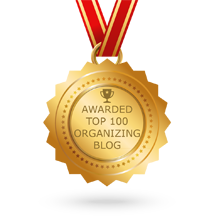
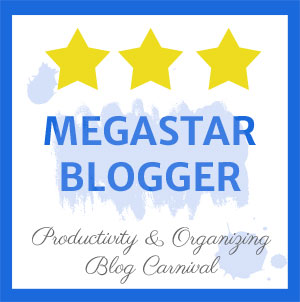
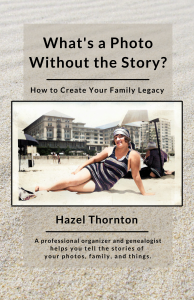
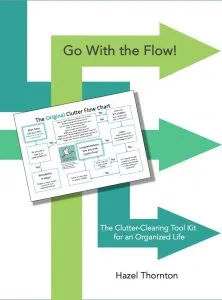
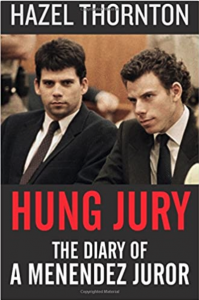
Great information, Hazel. I am the family’s historian and found that when I had to go through all the old photos, I couldn’t keep the names straight. Since I am a scrapbooker, I decided to make a scrapbook of my family. I labeled each photo and included various pieces of documents like my parents’ naturalization document. Everyone that comes over wants to see it. It has become a treasure in our family. Hopefully, the kids will add to this when we are gone. We shall see.
That’s great, Sabrina! Adding photos and telling the stories behind them make names and dates so much more interesting and keep your family history alive!
I’m not particularly good at this, but I’ve been inspired to be more mindful about it. My mother gave me a ring of hers as a Christmas gift, and just TODAY (before reading this), I asked her to please write the story of the ring out for me. Not only do I want the information, but I’d love it to be in her hand writing. So, baby steps, but I’m getting there!
Oh, that’s wonderful! My new book will be all about telling the stories of our families and our things. To have the story in your mom’s handwriting will be a treasure.
I like the guidelines you give and the reasoning behind the choices for organizing your genealogy materials. Your system has a lot of flexibility in it, which is key. As we know, not every mind thinks alike. Having the ability to categorize, sort, and store in a way that makes sense for the individual is important.
I loved the interview Julie Bestry did this week with you, Janine, and Jennifer. Your love of genealogy came through for each of you. It’s wonderful how each of you has pivoted your businesses to offer genealogy services and have created a Facebook group to support one another.
I enjoyed reading the interview you did with Julie and this article was a great expansion for understanding more about your process and how it all works! Thanks for sharing!
Thanks for your comment, Melanie!
Great companion post to my interview with you, Janine, and Jennifer! People can follow your advice, step by step, to achieve genealogy greatness or hire you to make it all work! 🙂
Indeed! Here’s a link: Paper Doll Interviews the Genealogy Organizers